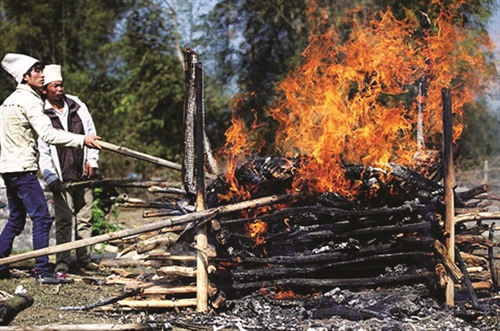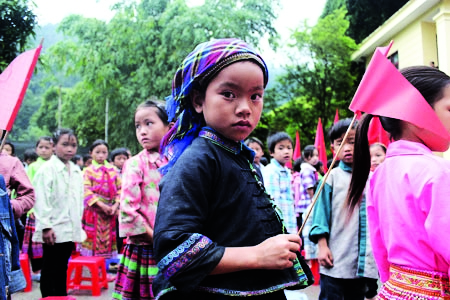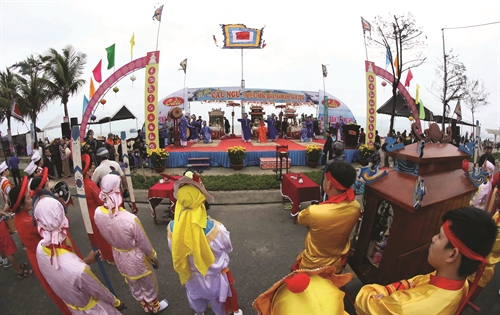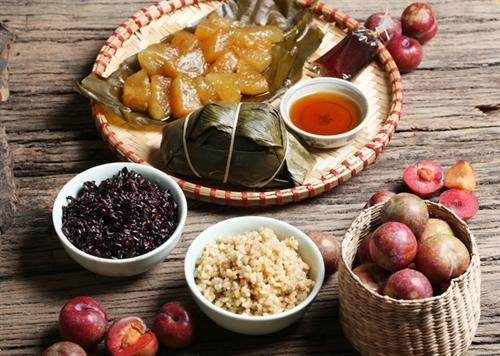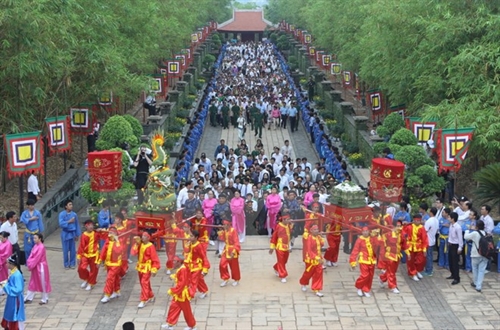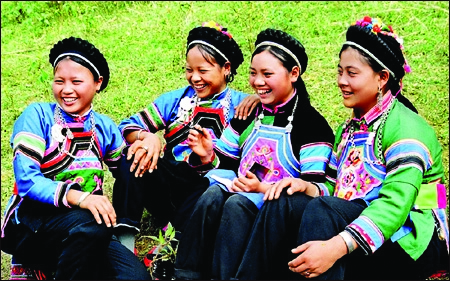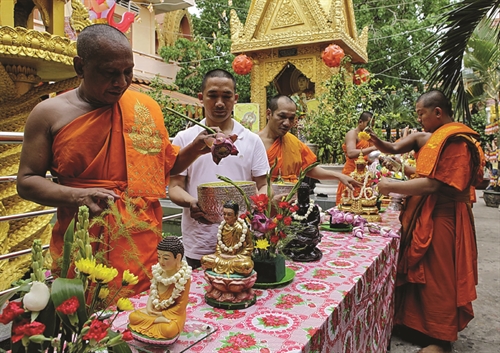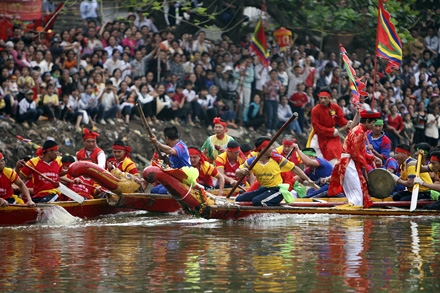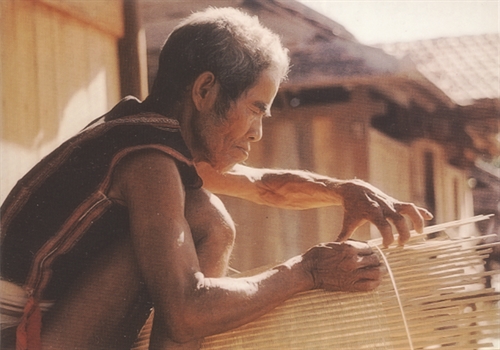>>Cremation, an age-old custom of the Thai
Ta Thi Tam
Ethnology Institute
Pot Dam, which means change of family name in the language of the Thai ethnic group in Vietnam, is an important ceremony for every Thai woman when she gets married.
Every Thai bride is supposed to undergo Pot Dam to change her family name to her husband’s in order to become an official member of her husband’s family and win his ancestors’ support.
Pot Dam marks the end of a woman’s single life as she will now wholeheartedly live for her husband and his family.
This ceremony is rooted from the Thai’s view that a married woman is supposed to follow her husband and become a member of his family even after death when her spirit will also belong to his family.
A bride who does not go through Pot Dam is believed to bring misfortunes to her husband, his family and her own children. She will also be neither protected by her husband’s ancestors nor regarded as a spirit of his clan after her death.
Pot Dam is usually held in a wedding together with the formality to take the bride to the groom’s home or after the wedding, depending on the couple’s conditions.
The date of this ceremony must be chosen carefully and must not fall on the birthday or death date of an ancestor of either the wife or the husband.
More important, Pot Dam must be held in the order of hierarchy of both families. If the wife has an eldest brother, she can only hold Pot Dam after this ceremony has been completed for this brother’s wife. If she has no brother but sisters, Pot Dam must be held for her oldest sister first. Meanwhile, the husband can only hold Pot Dam for his wife after all his older sisters-in-law have held this ceremony, but does not have to wait for his own sisters to hold the ceremony first. In a special case when a younger brother needs to hold Pot Dam for his wife before his sister-in-law’s, he must get the consent of this brother and his wife through a ceremony conducted by a shaman at the brother’s home. Offerings of this ceremony, which are prepared by the younger brother, include a pig or a chicken, a bottle of liquor, some rice and money. After this ceremony, the couple must also ask for permission from the husband’s ancestors in a similar formality conducted at the home of his parents. Only after completing these formalities, can the younger brother hold Pot Dam for his wife.
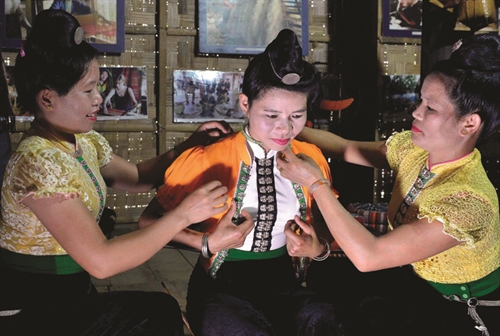 |
| Making up a Thai bride in a traditional wedding of the Thai ethnic group __Photo: Thanh Ha/VNA |
To prepare for Pot Dam, a Thai couple must prepare offerings to the wife’s parents to get their permission for the wife to adopt the family name of her husband. The offerings include a pig, four pairs of chickens, which must be cockerels or pullets, and salted and dried fish. The pig and chickens must be raised by the couple while the fish must be caught by the husband and salted and dried by the wife. The couple must prepare these offerings themselves to show the husband’s respect for his parents-in-law and the wife’s housewifery skills. The offerings also include four or eight packs of pipe tobacco, liquor, rice, money, and other foods which must be sufficient to make a feast for the wife’s family, relatives and villagers. An indispensable offering is two rolls of white cloth woven by the wife herself, which show the virtue and talent of a Thai woman as a wife and a daughter. A roll of beautifully woven cloth is proof of a wife who can take good care of her children and husband and of a dutiful daughter who loves and cares for her parents.
To hold the ceremony, the couple, their children (if any, in case the ceremony is held after the wedding) and a representative head for the wife’s home on a good date, bringing all the offerings. The representative should be a relative of the husband who is a smooth-tongued woman coming from a well-off family. Arriving at the wife’s home, the representative explains the purpose of the visit to the wife’s parents who will ask an old man, usually the grandfather of the wife, or a shaman to take charge of all ritual formalities.
The couple then prepares a tray of offerings to the wife’s ancestors with the help of her relatives and villagers. The offerings include a pig head, a chicken, grilled and fried pork rib, fried pig innards, fried or grilled chopped pork wrapped in banana leaves, pig blood pudding, sticky rice, soup, four cups of liquor, four cups of tea, four bowls and four pairs of chopsticks placed in the four corners of the tray in the belief that the ancestors from four directions of heaven will return home to receive the offerings.
Once the offerings are ready, the couple and their children (if any) kneel in front of the ancestor altar while the ritual conductor recites prayers, asking the wife’s ancestors to allow her to leave her clan to join her husband’s and to protect the couple and their family. When the praying formality finishes, the couple kowtows three times in front of the ancestor altar. Then comes the formality to get consent of the wife’s parents in which the representative of the husband’s family asks for the parents’ permission for their daughter to change her family name. The couple kowtows to the wife’s parents who then talk on the morals of husband and wife and how to build a happy family. After that, the parents give the couple some gifts which are silver jewelry and new clothes for their grandchildren, if any. The mother also gives her daughter a set of new clothes and two green cloth belts. The wife’s relatives then give the couple kitchen utensils and cloth. After the gift giving formality, the couple invites all relatives and guests to a feast to show the husband’s gratitude and respect for his wife’s family.
After the feast, a representative of the wife’s family sings to wish the couple peace, happiness and prosperity before they leave for the husband’s home at a chosen hour. The wife’s family send a party to escort the couple home who help carry all gifts the couple has received from the wife’s family. The more gifts they get, the greater pride they have for the love the wife’s family has given to them.
When the party escorting the couple arrives at the husband’s home, its representative will ask for permission from the husband’s family to come in. The representative of the husband’s family will ask questions which must be all answered by the representative of the wife’s before the party can enter the house. The husband’s family also prepares an offering tray for a formality to ask the husband’s ancestors to accept the wife as a new family member, which is similar to that conducted at the wife’s home. The couple also kowtows in front of the ancestor altar when the ritual conductor prays for the ancestors’ acceptance of their new member. From now on, the wife officially becomes a member of her husband’s family and is believed to win his ancestors’ support. At the end of the ceremony, the mother gives her daughter-in-law earrings, bracelets, necklaces, dresses and cloth belts.-
